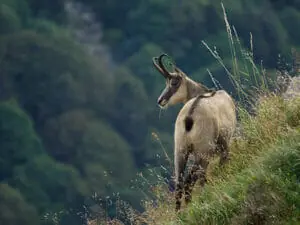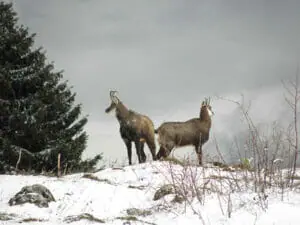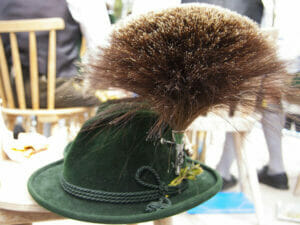Fascinating. At least to me. And do you know what? Chamois look cool, too. I don’t know why but I always think that these chamois animals look like they’re up to something.
So what is a chamois and what different types are there? Where may I be able to see some in the wild? And first of all: what are their characteristics? Questions upon questions. So let’s make a start to find out everything about the rupicapra, as is their Latin name.
Facts and figures – a profile of the chamois
As you can imagine, there isn’t just one type of chamois. As is often the case in flora and fauna, the term “chamois” refers to a whole species.
Chamois are native to Europe and the Middle East. They mainly populate high mountain ranges from the Pyrenees to the Caucasus. Steep, rocky terrain is the home of the rupicapra. It’s no surprise then that these animals are true artists when it comes to climbing, putting to shame a lot of hikers and mountaineers.
The Alpine chamois is a typical representative, which, as the name suggests, mainly occurs in the Alps. Let’s have a closer look at this sub-species.
Alpine chamois (Rupicapra rupicapra rupicapra)
Family: Bovidae
Sub-family: Caprinae
Tribe: Caprini
Genus: Rupicapra
Species: R. rupicapra
Head-torso length: 110-130 cm
Shoulder height: 70-85 cm
Weight: females 35-50 kg; males 35-50 kg
Special features: both sexes have horns of up to 25 cm.
Habitat: steep slopes, low and high mountain regions
Mainly active: during the day
Food: leaves, shoots, buds, grasses and herbs
Mating season: November/December
Gestation period: 6 months
Life expectancy: 15-20 years
Population in the Alpine region: around 500,000 (estimated in 2020)
Appearance and characteristics – this is what chamois look like
Chamois are part of the goat family which is obvious when you see them. Their bodies are strong, yet stout. Their legs are relatively long and powerful. Chamois goats are cloven hoofed animals. The large hooves allow excellent surefootedness even in extreme terrain. These animals also have a slim neck and a short head that tapers significantly towards the nose.
Whether male or female, the horns stay for their entire lives and are not shed. In technical German jargon, the horns are called “Krickel” or “Krucken”. They’re relatively short at an average length of 25 cm. They’re also round, quite straight and hooked backwards near the tip.
These horns continue to grow for the lifetime of the chamois and feature growth rings that can give an indication of the age of the animal. Compared with the ibex, chamois are much slighter and their horns are less imposing.
Depending on the time of year, the appearance of the chamois changes. In winter, their fur is dark-brown to almost black, whereas the summer fur is mainly reddish brown and yellowish brown around the abdomen. The dorsal stripe, however, is visible year round. This is a dark section of fur which forms an almost black stripe along the spine from the back of the head to the tail.
The head of the chamois is mainly light in colour. From the ears to the nose, however, they feature a dark longitudinal section of fur. This face mask with what is known as bridle reins is typical of adult chamois, giving them their signature look.
Lifestyle and distribution – home of the chamois
The steeper the better! That is certainly the chamois motto because they populate rocky terrain and steep slopes with an incline of up to 60°. You will often see chamois in high mountains regions at around 1,000 to 2,500 metres, but they also live in the woods at much lower altitudes. In low mountain ranges, such as the Vosges Mountains or in the Black Forest as well as the Swabian Mountains, they can sometimes be spotted at an altitude of around 400 metres if the terrain is suitable.
Where the chamois animals like to roam depends on the time of year. During warm summers, they often frequent shady and therefore cooler northern slopes. During the winter, on the other hand, the chamois will prefer the southern side of mountains where the sun increases the temperature. When there’s a lot of snow in winter, the rupicapra like to search for food in steep and exposed areas. This is because snow doesn’t remain on the ground as much there and the snow cover is therefore reduced, meaning the chamois will find food more easily. Another place of retreat in winter are steep mountain forests.
But why do chamois goats mainly live in steep and exposed terrain and what makes them almost perfect climbing artists? Chamois have several natural predators. These include wolves, golden eagles as well as lynx and bears.
Selecting a habitat on steep slopes is thus a clear strategy to avoid predators because lynx, wolves or bears would not follow into such exposed terrain. Golden eagles will generally only kill young animals because adult chamois are too big.
Chamois are cloven hoofed animals. That means their hooves consist of two parts, what is known as sections or toes. Firstly, they’re very flexible and can perfectly adapt to the terrain. Secondly, the edges of the hooves are very sturdy. Together with the sole that has similar properties to hard rubber, the hooves form an ideal unit for getting around difficult terrain.
Chamois don’t have to practise their excellent surefootedness, it’s basically a part of their DNA. Even soon after being born, kids can follow their mothers and master even very exposed terrain without difficulty.
They may be true climbing artists but chamois don’t generally go far during their lifetime. Female chamois in particular will usually stay in the same area and just move around there. Chamois often live in groups, otherwise known as herds. These normally consist of several mothers and kids or are purely bachelors. Older bucks often live by themselves and will sometimes travel long distances for procreation.
Mating season for chamois is in November and December. During this time, the bucks in particular will try to show off to attract females and scare off potential competitors. After a gestation period of around six months, the young will be born in May or June.
Nature conservation and hunting – chamois and people
Alpine chamois are game that can be hunted because they’re not endangered in the Alpine region. However, hunting chamois is subject to the Fauna Flora Habitat Guidelines (FFH) specified by the EU, thus restrictions apply. Specifically: only when the conservation status is deemed as favourable.
This categorisation is organised by the individual countries and is based on methods that can vary widely and are a little controversial. Generally, the chamois population in the Alpine region is categorised as stable. Most recently, only France has recorded a slight decrease.
But it is not just hunting that has an impact on the chamois population. It has been observed in some areas that large numbers of chamois are leaving high Alpine regions and populate forests at lower altitudes. The main reason for this seems to be human influence on the habitat of the rupicapra.
Wild chamois are shy animals that flee from humans. During the winter in particular, they need a lot of energy for this. However, it’s hard to cover this energy requirement with the limited food supply. Therefore the appeal again: when you’re out and about in the mountains, stick to the paths and planned routes. Do not go cross-country, and certainly avoid areas marked as wildlife reserves which are places of refuge for the animals.
(More or less) useful chamois facts – any other info…
Male or female?
If you’re in the wild and you want to know whether the chamois you can see with your binoculars is male or female, you have two options. If you have very good binoculars, you can look closely (there is barely any distinction in appearance between male and female).
Or you wait until the animal relieves itself. Yes, that’s right, when it urinates, does a wee, waters the flowers … you know what I mean. Whereas a female squats down as you may know from cats, a male will stretch forwards and wee directly behind himself.
The thing with the Gamsbart…
A Gamsbart is not something a chamois has in its face. It’s not an actual “beard”, but it refers to the back hair of a chamois buck. It grows along the spine and can reach a length of 20 centimetres. During the mating season, bucks use this hair to impress females. By erecting the Gamsbart, they will look taller and therefore, stronger, more handsome, attractive… you know the deal. The Gamsbart that hunters like to wear on their hats actually consists of the back hair of a chamois buck, depending on the way it’s made.
Chamois leather sponges
The next time you’re in your car and you’re reaching for your chamois leather sponge because your windscreen has steamed up, you may like to remember that this material was traditionally made from the hide of the chamois. After the tanning process, the leather is extremely absorbent yet not at all abrasive, which makes it perfect for cleaning damp surfaces whilst avoiding scratches.







